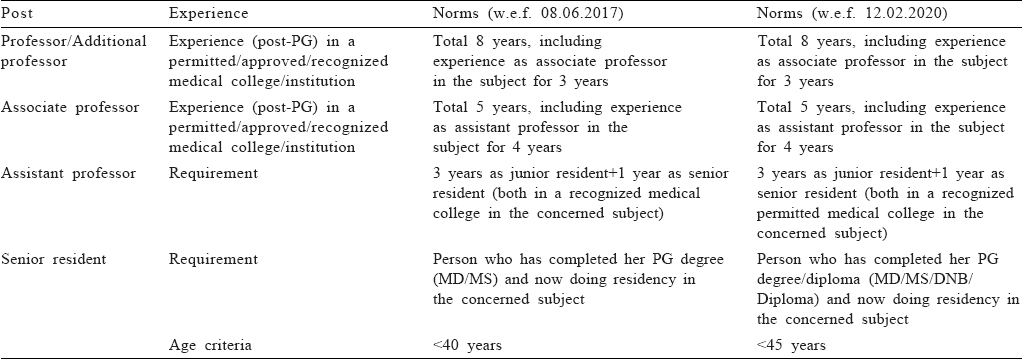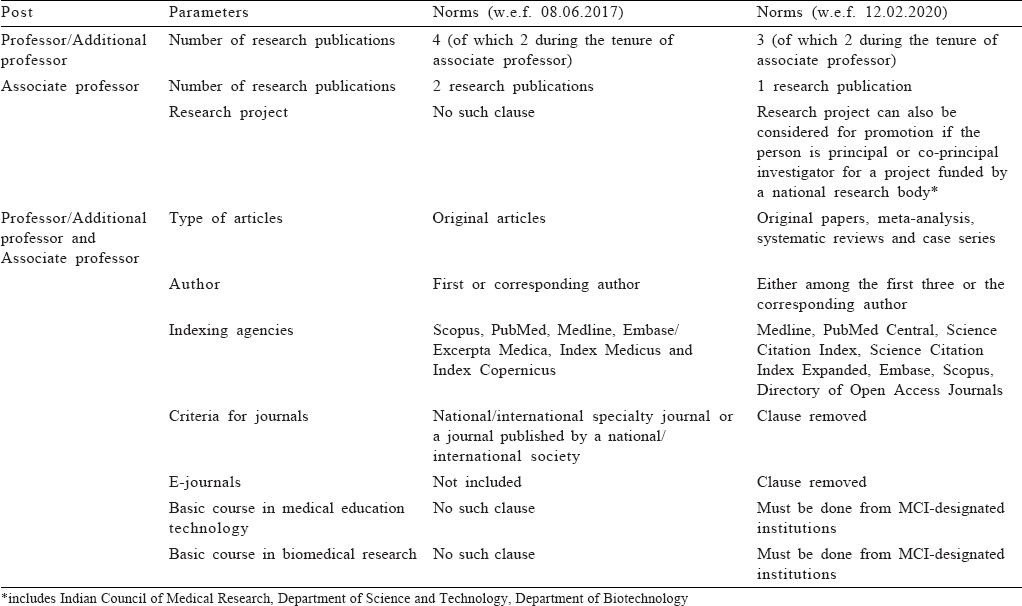Translate this page into:
Critiquing the revised minimum qualifications for promotion of medical teachers in India
Corresponding Author:
Saurabh RamBihariLal Shrivastava
Department of Community Medicine, Shri Sathya Sai Medical College and Research Institute, Sri Balaji Vidyapeeth – Deemed to be University, Chengalpet, Tamil Nadu
India
drshrishri2008@gmail.com
| How to cite this article: Shrivastava SR, Shrivastava PS. Critiquing the revised minimum qualifications for promotion of medical teachers in India. Natl Med J India 2020;33:316-318 |
A medical teacher in a broad specialty progresses from an assistant professor to professor after attaining the prescribed teaching experience [Table - 1] and requisite experience in research and teaching [Table - 2].[1],[2] The Medical Council of India (MCI) has been proactively prescribing and revising these guidelines periodically not only to improve the earlier guidelines but also to enhance the competency levels of faculty members, especially in the domains of research and teaching–learning.[1],[2] However, it is worth noting that till the last notification dated June 2017, no specific importance was given to teaching–learning, research projects or acquisition of research skills through training programmes and attention was given only to publications. This attracted criticism as teaching and research go hand-in-hand.[3] Thus, to respond to all the lacunae and to formulate comprehensive guidelines for the minimum qualifications of teachers in medical colleges, the MCI made an amendment dated 12 February 2020 [Table - 1] and [Table - 2]).[2]


It is important to understand that these guidelines aim to enhance the quality of medical teachers and a period of 2 years has been given for implementing these norms. In this transition period of 2 years, the earlier guidelines can be followed for promotion in medical institutions, which shows that the regulatory body has covered all the bases.[2] Some key additions/deletions in the newly recommended gazette notification are:
- Types of article. The list of accepted types of articles has been expanded. Apart from original articles, articles under the categories of meta-analyses, systematic reviews and case series have been added. Meta-analyses and systematic reviews are placed at the top level in the ladder meant to assess the quality of research papers. However, case series have been included to assist clinicians who might have a heavy workload and who do not find adequate time for doing an original study. To maintain some standard, the MCI has not included case reports.
- Authors. This has been one of the most debatable parameters. Various faculty members expressed that it was difficult for them to get the benefit of their work in terms of promotion as the criteria were limited only to the first and the corresponding author. The revised guidelines have expanded the criteria, and now the benefit of promotion can be availed by the first three authors and the clause of the corresponding authors remains intact. Thus, a greater number of authors can benefit from their work.
- Indexing agency. The indexing agencies in which journals may be listed now include the Science Citation Index and Directory of Open Access Journals (DOAJ).
- Journal criteria. The earlier guidelines concerning subject-specific journals or those published by a society were vague and subjective. Thus, their removal is a welcome step, and it will bring more transparency in the process of promotion, besides introducing clarity for MCI inspections of medical colleges.
- Additional inclusions. The promotion of a teaching faculty to the next level should not depend only on research publications.
Acknowledging this, three new parameters have been proposed in the revised norms, namely–
- Research project. With an aim to increase the number of funded research projects and also to help faculty members who have failed to publish their research according to the criteria specified for promotion, an alternative option has been given for their professional growth. This can be accomplished provided a faculty member (principal investigator or co-principal investigator) succeeds in getting approval for a funded study from a national research body, which will indirectly mean better grant proposals.
- Basic course in medical education technology. In order to strengthen the national mission of faculty development, especially in the field of medical education, MCI has included a mandatory criterion that for any promotion (assistant to associate or associate to professor), faculty members have to be trained in the basic course. This is crucial as we cannot teach the future generation of medical students using techniques of the past generation and we have to be trained in modern/innovative teaching–learning methods. This will not only improve our curriculum delivery but will also aid all faculty members in evaluating their teaching sessions and the course as a whole. It will be an important step for newly recruited faculty members, who have no exposure to teaching–learning. Further, it will benefit medical education in the nation as we are still in the nascent stages of implementation of the competency-based undergraduate curriculum.
- Basic course in biomedical research. Another mandatory criterion is that faculty members have to do a basic course in biomedical research. This recommendation was introduced in 2019 for postgraduate students and was optional for faculty members.[4] However, the new guidelines make it mandatory even for faculty members. This is an important step to improve/refresh the research aptitude and skills of medical teachers.[4],[5] This will further aid in not only helping them to write better research projects, but will play an important role in passing their knowledge to both undergraduate and postgraduate students.
The new guidelines have been drafted after much deliberation and attempt to improve the existing norms of minimum qualifications of medical teachers. In the revised guidelines, impetus has been given to teaching–learning, writing skills (submitting a proposal for grants) and research skills (through encouraging faculty members to attend online research courses) for deciding the promotion of a faculty member. At the same time, clinicians’ interests for promotion have also been addressed through the inclusion of case series.
Critique of the recent amendments
One criticism of the recent amendment is that DOAJ has been included, which is not a better parameter, especially considering the other indexing agencies (viz. PubMed, Scopus and Science Citation Index), which are being included. These guidelines will also aid in the successful implementation of the competency-based curriculum for undergraduate students.
In conclusion, the new guidelines are a major improvement, and it is up to us faculty members to accept these in a positive manner and use these for self-directed learning and professional growth.
Conflicts of interest. None declared
| 1. | Medical Council of India. Minimum Qualifications for Teachers in Medical Institutions Regulations, 1998. Substitution of Clause 6 in Schedule 1. Medical Council of India; 2017. Available at www.mciindia.org/documents/e_Gazette_ Amendments/TEQ-08.06.2017.pdf (accessed on 20 Feb 2020). [Google Scholar] |
| 2. | Board of Governors–In Supersession of Medical Council of India. Minimum Qualifications for Teachers in Medical Institutions (Amendment) Regulations, 2019. New Delhi:MCI Press; 2020:5–9. [Google Scholar] |
| 3. | Bandewar SV, Aggarwal A, Kumar R, Aggarwal R, Sahni P, Pai SA. Medical Council of India’s amended qualifications for Indian medical teachers: Well intended, yet half-hearted. Natl Med J India 2018;31:1–4. [Google Scholar] |
| 4. | Medical Council of India. Online research method course for postgraduate students and faculty. Medical Council of India; 2019. Available at https://mciindia.org/CMS/wp-content/uploads/2019/07/Notice-Online-Research-09.07.2019.pdf (accessed on 20 Feb 2020). [Google Scholar] |
| 5. | Medical Council of India, ICMR, NIE. Basic course in bio-medical research: Online course for post-graduate medical students and faculty. Medical Council of India, ICMR, NIE; 2019. Available at https://mciindia.org/CMS/wp-content/uploads/ 2019/07/Information-bulletin-PG-research-Methods-course-2019-20.pdf (accessed on 20 Feb 2020). [Google Scholar] |
Fulltext Views
3,420
PDF downloads
1,192




